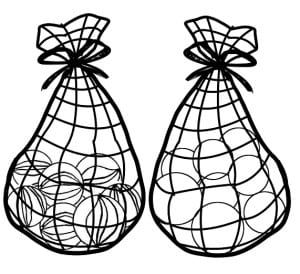Preschoolers need to progress through 3 stages of understanding to learn how to compare numbers. Learn all 3 stages so you can help your child develop a deep understanding of numbers.
One of the things that’s hardest about teaching math is figuring out how to break concepts down into small, manageable chunks. So many math concepts that seem obvious to adults are actually very multi-layered and complex for kids who are approaching them for the first time.
Comparing numbers is one of these challenging concepts for young children. While it’s obvious to adults that 8 is more than 7, it takes a long time (and a lot of hands-on experience) for children to understand that numbers that come later in the counting sequence are greater than the numbers that come before.
In this excerpt from my preschool homeschool math curriculum, Preschool Math at Home, you’ll learn the skills your preschooler needs to develop as she learns to compare numbers.

Comparing numbers and quantities: Which has more?
(Excerpt from Preschool Math at Home)
Learning to compare quantities helps preschoolers begin to make sense of the relationships between numbers: seven is one less than eight, but it is one more than six. Your child will build on these relationships in kindergarten addition and subtraction. For example, a kindergartner might use her knowledge that eight is one more than seven to solve 7 + 1.
Preschoolers already understand the concept of more and less informally, especially if they feel that someone else is getting “more” and they are getting “less”! Even without any instruction, most are able to compare quantities if only small amounts are involved, or if two quantities are very different from each other visually. For example, in the pictures below, your child could probably tell right away which box of cars has more cars, or which plate of cookies has fewer cookies.

But comparing larger quantities (or quantities are that look about equal) is much more difficult. To learn to make these more difficult comparisons, preschoolers need instruction and lots of practice. For example, in the picture [below], most young children would find it very difficult to tell which bag has more marbles.

Preschoolers who are just learning to compare larger quantities begin by matching the objects one-by-one to see which group has more.

Then, as they gain more experience with comparing, children learn that they can use counting to compare quantities: “There are seven striped marbles and eight plain marbles. Eight comes after seven, so eight marbles is more than seven marbles.”
Check out my book, Preschool Math at Home, for more simple, playful math activities to give your preschooler a great start in math.


I love this! Thanks for breaking it down to the individual skills! So helpful. Curious what you’d recommend for the 6 year old who is right between the Preschool and Kindergarten skill set. How do you recommend filling in the gaps? Thanks a bunch!
Glad you found it helpful, Kara! For a six-year-old who’s in-between, I’d go ahead and begin a kindergarten curriculum. Most kindergarten programs start at the beginning with simple number work, so he should be able to jump right in.
Happy Math!
Kate
Tnx this was helpful for my school assignments